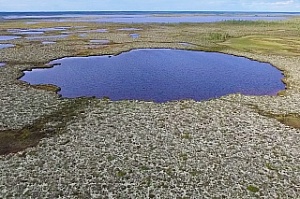Scientists at TSU, Umeå University (Sweden), and Midi-Pyrenees Observatory (France), under the SIWA (Siberian Inner Waters) international project, have studied for the first time the emission of greenhouse gases from thermokarst lakes in the cryolithozone of Western Siberia on a latitudinal gradient. The scientists have found that bodies of water formed as a result of melting permafrost emit a large number of greenhouse gases, and the maximum emission of carbon dioxide and methane is in the offseason. The research results of the international group are published in Nature Communications.
The interest in thermokarst lakes is very high, they have been actively investigated over the past few decades; however, previously Russian and international scientists worked locally, paying attention to only a few objects. As a rule, samples taken during one season were studied.
The first comprehensive studies of lakes in the Arctic zone of the Russian Federation were carried out by the TSU Bio-Geo-Clim Laboratory, headed by Oleg Pokrovsky, a scientist at TSU and the Midi-Pyrenees Observatory (Toulouse, France).
- Western Siberia has the world's largest frozen peat bog, which contains huge reserves of organic carbon,- says Ivan Kritskov of the Bio-Geo-Clim laboratory. - In the process of permafrost melting, carbon is released and partially migrates to adjacent bodies of water. However, a high concentration of dissolved carbon in the lake water does not guarantee the release of greenhouse gases into the atmosphere. In the course of research, we were able to determine the factors influencing the activeness of emissions, such as the depth of the lake, the air and water temperature, atmospheric pressure, air flow, and the intensity of greenhouse gas emissions into the atmosphere.
Sampling was carried out on 76 lakes in the Khanty-Mansi and Yamal-Nenets Autonomous Districts. Studies were conducted three times during the entire period of open water - in spring, summer, and autumn. The scientists measured the concentration of dissolved carbon in the lake water and studied the elemental composition and the volume of carbon dioxide and methane emissions from the water surface. As it turned out, the maximum emission of greenhouse gases occurs in spring, when lakes open up after winter and release reserves accumulated during the winter into the atmosphere, and in the autumn during the period of prolonged rains, when the water-covered area increases significantly.
- We tried to find out how strongly natural factors (size of lakes and watersheds, type of permafrost, and seasonality) affect greenhouse gas emissions,- says Artem Lim of the Bio-Geo-Clim Laboratory. – The results showed that latitude and seasonality have the greatest value on emissions, so emissions grow from south to north and reach their maximum in the zone of continuous permafrost, where they are 2–5 times more than in the south.
The comprehensive studies conducted by this international scientific group obtained a large array of unique data on the contribution of thermokarst lakes in Western Siberia to the greenhouse effect. This will enable a better understanding of the environmental transformation processes occurring in the Arctic zone of the Russian Federation and making much more accurate predictions about what will happen with permafrost and what climate changes humankind should expect in the future.
The authors of the article “High Carbon Emissions from Thermokarst Lakes of Western Siberia” are Svetlana Serikova (Umeå University, Sweden), Oleg Pokrovsky (TSU and Midi-Pyrenees Observatory), Rinat Manasypov (TSU), Ivan Kritskov (TSU), Artem Lim (TSU), Hjalmar Laudon (Uppsala, Sweden, Department of Forest Ecology and Management), and Jan Karlsson (University of Umeå, Sweden, Department of Ecology and Environmental Science).

